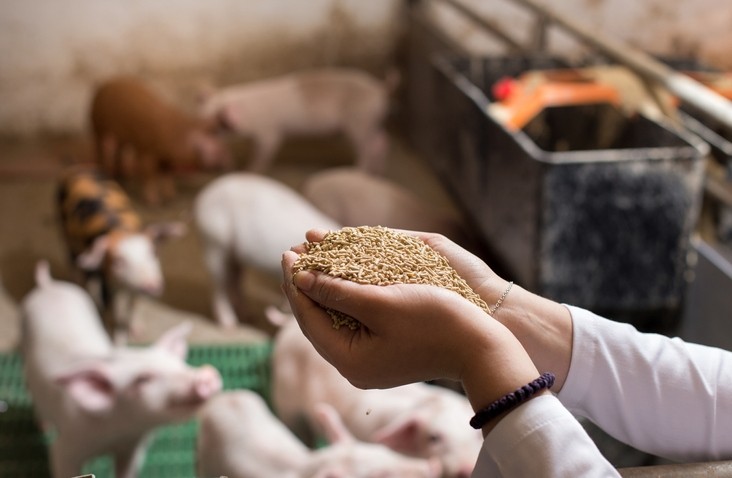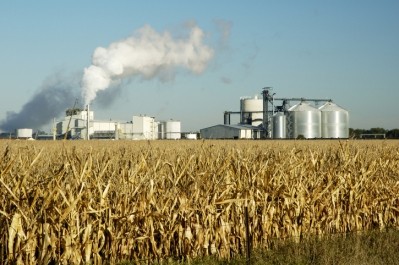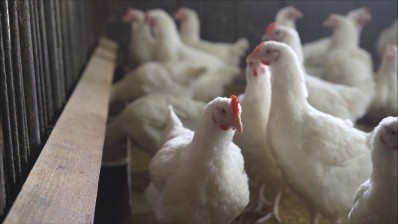Low-oil DDGS provide less energy, more digestible amino acids than conventional sources

A team of researchers from the University of Illinois examined the nutrient content from a selection of low-oil dried distillers grains with solubles (DDGS) for use in swine diets. The study was published in the journal Translational Animal Science.
The project looked at low-oil DDGS from a range of production facilities in the US, said Hans Stein, professor of animal science, the University of Illinois. The sampling was intended to be representative of the low-oil DDGS currently generated in the that market, he explained.
“In earlier research, we demonstrated that there was quite a bit of variability among sources of conventional DDGS in terms of digestibility of both energy and in particular amino acids,” he told FeedNavigator. “But, over the last five to six years, most of the industry has moved towards producing what we call low-oil DDGS … there has been less research published on this source of DDGS, though this is almost all that is now produced.”
“Because conventional DDGS had been shown to have quite a bit of variability, we wanted to determine whether that is also the case for low-oil DDGS,” he added. “We also wanted to make sure we knew what the energy value of low-oil DDGS is – because, with less fat, we expected to have reduced energy concentration.”
They saw that the metabolizable energy in the low-oil DDGS was lower than for conventional distiller grains with solubles. However, the team also reported that the digestibility of amino acids was high in low-oil DDGS than in conventional DDGS.
Feed formulators should update the nutritional value for DDGS to reflect what has been seen in this study, he said. “That way this ingredient can be used to maximize growth performance of animals.”
Low-oil DDGS – the unknowns
Distillers dried grains with solubles (DDGS) is a coproduct from ethanol production and has been successfully included in diets fed to ruminants, pigs, and poultry (Stein and Shurson, 2009; Liu and Han, 2011).
Conventional DDGS contains 10% to 14% fat (NRC, 2012), but the majority of ethanol plants in the US now collect fat from the solubles, which results in the production of low-oil DDGS that contains between 6% and 9% fat (NRC, 2012; Kerr et al., 2013).
Addition of fat to diets fed to pigs often increases the digestibility of amino acids (AA; Cervantes-Pahm and Stein, 2008; Kil and Stein, 2011), and it is, therefore, possible that removal of fat from DDGS influences the digestibility of AA in DDGS, wrote the researchers.
Indeed, compared with conventional DDGS, the apparent ileal digestibility (AID) and the standardized ileal digestibility (SID) of AA were reduced in two sources of low-oil DDGS that were produced by one ethanol plant (Curry et al., 2014). However, it is not known if this effect is something that is generally observed in low-oil DDGS or if it can be attributed to a specific supplier, said Stein and his team.
Values for digestible energy (DE) and metabolizable energy (ME) in low-oil DDGS produced in and around Illinois are reduced compared with conventional DDGS (Curry et al., 2016), but the concentration of fat in DDGS is not always correlated with the ME of DDGS (Kerr et al., 2013), they explained.
In addition to the differences in fat removal procedures among ethanol plants, different plants also use different enzymes in the production. This may result in some of the neutral detergent fiber (NDF) being degraded, which may result in differences in the fermentability by pigs of the NDF in different sources of DDGS, but this hypothesis has not been verified, said the researchers.
Therefore, the objective of their current research was to test the hypothesis that the digestibility of crude protein (CP), AA, gross energy (GE), acid hydrolyzed ether extract (AEE), and NDF, and the concentration of ME in low-oil DDGS vary among suppliers of DDGS due to differences in production processes.
Feed assessment trials
Two experiments were conducted.
In the first trial, researchers checked the apparent total tract digestibility (ATTD) for nutrients in eight sources of low-oil DDGS, the researchers said. They also assessed the DE and ME of the ingredient.
In the 14-day feeding trial, 72 pigs received one of nine diets – a control diet with corn or one of eight feeds containing low-oil DDGS from different feed mills in the Midwest in the US, they said.
Feed consumption was noted daily and fecal matter and urine were collected for assessment on days eight to 13, they said. Samples were checked for GE, AEE, dry matter (DM), NDF, crude protein (CP), ash, acid detergent fiber (ADF), insoluble dietary fiber and soluble dietary fiber.
“The ATTD of DM, GE, AEE, and NDF, and the DE and ME were calculated for each diet,” the team wrote.
In a second experiment, the researchers assessed the ileal digestibility of crude protein and amino acids for seven sources of low-oil DDGS, they said.
In that feeding study, 24 pigs received one of eight diets for a seven-day period before being rotated to another trial diet, they said. The diets included one of the seven sources of low-oil DDGS and a nitrogen-feed basal diet.
Ileal digesta samples were collected for analysis on days six and seven of each feeding period, they said.
Results and next steps
In the first feeding trial, swine remained healthy through the study and had similar feed intake across all experimental diets, the researchers
The ATTD of DM and GE were higher in the basal diet than all the trial diets and the ATTD of AEE in the source E diet was higher than that in the source A diet, they said. ATTD of NDF altered across test diets and the basal diet was higher in DE than the source E diet and higher in ME for all diets except the source D feed.
ATTD of FE, DE and ME values were similar for all DDGS, except source E, which was lower in ME, they said. The ATTD of AEE and NDF were similar with the sources of DDGS – but, the ATTD of AEE in the source E feed was higher than for the source A and the ATTD of NDF in the source D diet was greater than sources E, G and H.
In the second study, the diets with DDGS A and B were the same in apparent ileal digestibility (AID) and SID for AA, the researchers said. The AID and SID of lysine, methionine and tryptophan were similar for DDGS sources A, B and E, however, the AID and SID of many indispensable and dispensable AA – except glycine – were higher for DDGS source B compared to sources C, D, E, G and H.
It was not a surprise that the energy value or metabolizable energy of the low-oil DDGS was lower compared to conventional DDGS, said Stein.
“Fat contains more energy than protein and carbohydrates and so when fat is removed, we expect less energy in the remaining part,” he said. “Results showed pretty much what we had expected.”
However, there were some surprises in the results generated through the second experiment, around the digestibility of amino acids in the low-oil DDGS samples evaluated, he said. “The low-oil DDGS contains more digestible amino acids than conventional DDGS,” he added.
The greater AID and SID of Lys in the DDGS sources used in the study compared with previous data are most likely a result of less heat damage in the current samples because Lys is usually the first AA to have reduced digestibility if samples are heat damaged, noted the paper.
“We believe the reason for this is that ethanol plants now do a better job of drying the distillers grains without over-heating – because over-heating results in reduced digestibility of amino acids and a lower concentration of some amino acids,” Stein said. “This is a positive for low-oil DDGS and this was not something we necessarily had expected to see.”
The fuel ethanol industry, reported the paper, continues to improve the nutritional value of DDGS by implementing improved technologies such as the use of more effective enzymes, better fractionation, and improved drying systems that assist in reducing heat damage in the DDGS.
The improved understanding of nutritional factors in low-oil DDGS could herald adjustments in feed formulation approaches, said Stein.
“They will either need to accept a lower energy value in the diets – or they need to add another source of high-energy ingredient (maybe fat) to maintain the same energy in the diet,” he said. “However, they can also reduce the inclusion rate of soybean meal because the low-oil DDGS contains more digestible amino acids than conventional DDGS.”
Source: Translational Animal Science
DOI: https://doi.org/10.1093/tas/txz025
Title: Digestibility of amino acids, energy, acid hydrolyzed ether extract, and neutral detergent fiber, and concentration of digestible and metabolizable energy in low-oil distillers dried grains with solubles fed to growing pigs
Authors: C.D. Espinosa, S.A. Lee, H.H. Stein













